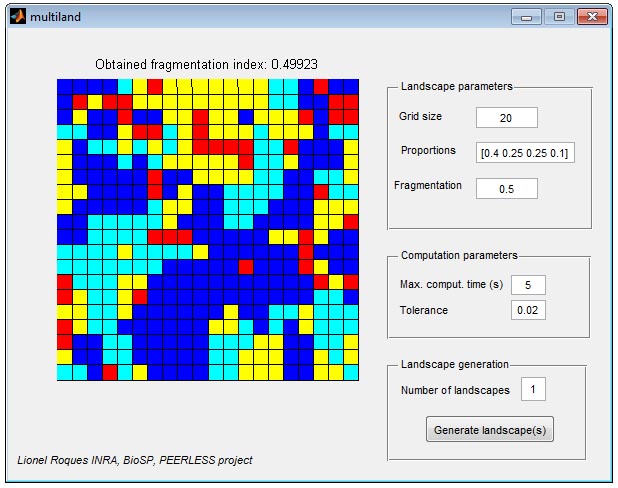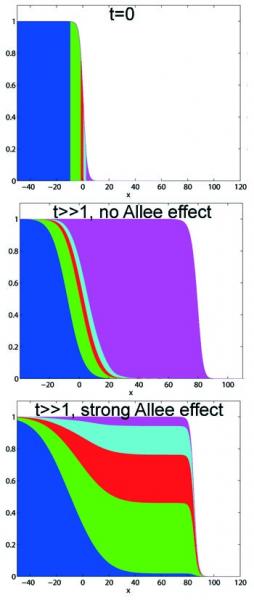Researcher: mathematics and modeling
INRAE |
- POSITIONS AND EDUCATION
2021-2023, Director of the BioSP research unit; INRAE Avignon
Since 2016, Deputy director of the BioSP research unit; INRAE Avignon
Since 2015, Senior Researcher (Directeur de Recherche), Biostatistics and Spatial Processes, INRAE Avignon
Since 2005, Researcher (Chargé de Recherche), Biostatistics and Spatial Processes, INRAE Avignon
2004,2005, Researcher (ATER) at Laboratory of Analysis, Topology and Probability, Aix-Marseille Université.
PhD Student, in the Laboratoire Jacques-Louis Lions (formerly Laboratoire d'Analyse Numérique), University Paris 6 (2001-2004).
- RESEARCH FIELDS
Nonlinear partial differential equations. Reaction-diffusion models in homogeneous and heterogeneous media. Traveling waves and spreading properties in homogeneous and periodic media. Inverse problems for parabolic equations with non-constant coefficients. Shape and eigenvalue optimization problems.
|
Evolutionary biology. Conservation biology. Effects of environmental factors on species extinction and survival. Population dynamics and population genetics. Mathematical studies of range expansions. Effect of habitat fragmentation, role of the Allee effect and of long distance dispersal events. Mechanistic-statistical modeling of biological invasions (tiger mosquito, pine processionary moth, megastigmus spp).
|
Spatio-temporal dynamics of genetic diversity in an expanding population modeled by a traveling wave. The existence of an Allee effect leads to a better conservation of genetic diversity [27,28]. |
- PROJECTS
Maths-ArboV (PEPR, 2025-2030) ReaCh (ANR, 2023-2028) BCOMING (Horizon-Europe, 2022-2026) Réseau MEDIA (INRA MIA, 2014-)
|
RESISTE (ANR, 2019-2023) NONLOCAL (ANR, 2015-2018) MECC (ANR, 2014-2018) HYBRIDE (INRA MIA, 2014-2016) PEERLESS (ANR, 2013-2016) ReaDi (ERC , 2013-2018) PCLIM (INRA ACCAF, 2011-2014) MACBI (ANR, 2011-2014) PREFERED (ANR, 2009-2012) URTICLIM (ANR,2008-2011) ColonSGS (ANR, 2008-2011)
|
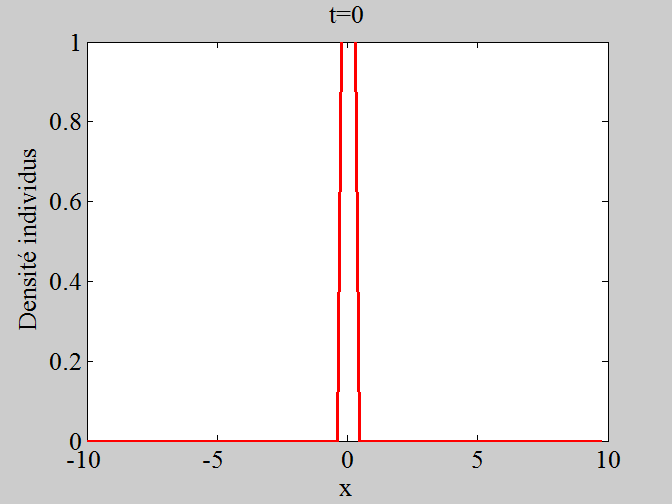 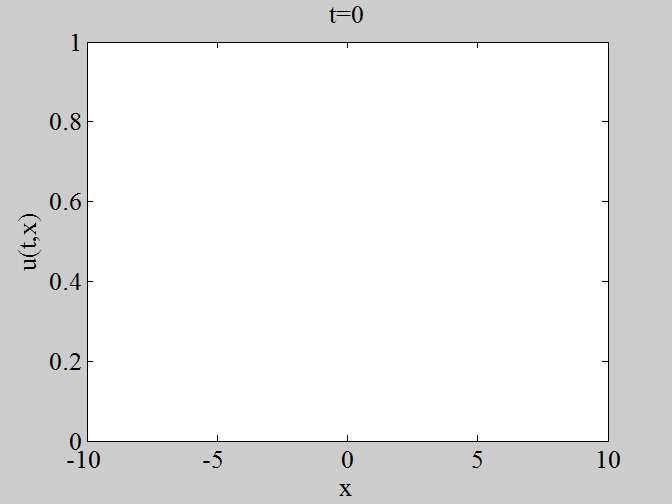 |
- THESES
2013: Habilitation thesis. Equations aux dérivées partielles pour l'écologie des populations. PDF
2005: PhD thesis (supervisor H Berestycki). Equations de réaction-diffusion non-linéaires et modélisation en écologie. PDF
- BOOKS
| 2013: Modèles de réaction-diffusion pour l'écologie spatiale. Editions Quae. |  |
- BOOK CHAPTERS
2023: Les invasions biologiques à la lumière des modèles. (Roques, L., Soubeyrand, S.) Crises sanitaires en agriculture: Les espèces invasives sous surveillance, 167 Quae. Link
2022: Inferring Mechanistic Models in Spatial Ecology Using a Mechanistic‐Statistical Approach. (Papaïx, J., Soubeyrand, S., Bonnefon, O., Walker, E., Louvrier, J., Klein, E.K., Roques, L.) Statistical Approaches for Hidden Variables in Ecology, 69-95. Link
2020: Modéliser les interactions du vivant, en lien avec les milieux et les contextes socio-économiques. (Gascuel C., Lescourret F., Monod H., Roques L., Bohan D., Costes E., Courtois P., Fabre F., Faverdin P., Franc A., Hoch T., Phocas F., Steyer J.-P., Tchamitchian M.) In : L’agroécologie : des recherches pour la transition des filières et des territoires. Collection Matière à débattre et décider. Éditions Quæ, 71-80. https://hal.inrae.fr/hal-02929956
2014: Modeling the spatio-temporal dynamics of the pine processionary moth. (L Roques, J-P Rossi, H Berestycki, J Rousselet, J Garnier, J-M Roquejoffre, L Rossi, S Soubeyrand, C Robinet). In : Processionary Moths and Climate Change: An Update, Springer. Link
2014: Medical and veterinary impact of the urticating processionary larvae. I Moneo, A Battisti, B Dufour, J C García-Ortiz, M González-Muñoz, F Moutou, P Paolucci, E Petrucco Toffolo, J Rivière, A-I Rodríguez-Mahillo, A Roques, L Roques, J M Vega, J Vega. In : Processionary Moths and Climate Change: An Update, Springer. Link
- PREPRINTS
M Alfaro, C Chane Ki Chune and L Roques (2025). Existence of two thresholds in a bistable equation with nonlocal competition. arXiv preprint, HAL.
L Roques (2025). Explicit pulsating fronts and minimal speeds in periodic Fisher-KPP equations. arXiv preprint, HAL.
N Nguyen, O Bonnefon, R Gato, L Almeida and L Roques (2025). Mechanistic-statistical inference of mosquito dynamics from mark-release-recapture data. arXiv preprint, arXiv:2510.06080.
N Boutillon, F Hamel, and L Roques (2025). Periodic KPP equations: new insights into persistence, spreading, and the role of advection. arXiv preprint, arXiv:2503.20390.
L Roques. Readi2solve: An Online Python Toolbox for Solving Reaction-Diffusion problems. hal-04728969.
L Miele, L Roques, D Constantinescu, M Genard, & N Bertin. Cell expansion-division under resource sharing: a novel framework for modeling fruit growth dynamics. bioRxiv, 2024-05 (2024).
P Zamberletti, L Roques, F Lavigne, J Papaïx. Spatial heterogeneity alters the trade-off between growth and dispersal during a range expansion ⟨hal-03770639⟩ (2022).
- JOURNAL ARTICLES
N Boutillon, Y-J Kim, and L Roques. Impact of diffusion mechanisms on persistence and spreading. Journal of Mathematical Biology, (2025) arXiv:2501.03816.
M Alfaro, F Lavigne, and L Roques. A host-pathogen coevolution model. Part I: Run straight for your life. Nonlinear Analysis: Real World Applications, 84, 104305 (2025). DOI arXiv:2409.02541.
L Roques, N Boutillon, P Zamberletti, & J Papaïx. Polymorphic population expansion velocity in a heterogeneous environment. Journal of Theoretical Biology, 595, 111932 (2024). DOI Preprint
[72] M Alfaro, F Hamel, F Patout, L Roques. Adaptation in a heterogeneous environment II: To be three or not to be. Journal of Mathematical Biology, volume 87, Article number: 68 (2023). DOI Preprint
[71] M Alfaro, F Hamel, L Roques. Propagation or extinction in bistable equations: the non-monotone role of initial fragmentation. DCDS-S (2023). DOI Preprint
[70] V Doublet, L Roques, EK Klein, F Lefèvre, & T Boivin. Seed predation-induced Allee effects, seed dispersal and masting jointly drive the diversity of seed sources during population expansion. Journal of Mathematical Biology (2023). DOI Preprint
[69] L Roques, T Boivin, J Papaix, S Soubeyrand, O Bonnefon. Dynamics of Aedes albopictus invasion. Insights from a spatio-temporal model. Biological Invasions (2023). bioRxiv. PDF
[68] C Gascuel-Odoux, F Lescourret, B Dedieu, C Detang-Dessendre, P Faverdin, L Hazard, I Litrico-Chiarelli, S Petit, L Roques, X Reboud, M Tixier-Boichard, H de Vries, T Caquet. A research agenda for scaling up agroecology in European countries. Agronomy for Sustainable Development, 42(3), 53 (2022).
[67] V Martinet, L Roques An ecological-economic model of land-use decisions, agricultural production, and biocontrol. Royal Society Open Science (2022) Preprint
[66] L Roques, D Allard, S Soubeyrand Spatial statistics and stochastic partial differential equations: a mechanistic viewpoint. Spatial statistics (2022) DOI PDF
[65] T Morel-Journel, M Haond, L Lamy, D Muru, L Roques, L Mailleret, E Vercken When expansion stalls: an extension to the concept of range pinning in ecology. Ecography (2022) DOI
[64] F Patout, R Forien, M Alfaro, J Papaïx, L Roques The emergence of a birth-dependent mutation rate: causes and consequences. Recommended in PCI Math Comp Biol (2021) PDF
[63] M Alfaro, L Girardin, F Hamel, L Roques When the Allee threshold is an evolutionary trait: persistence vs. extinction. Journal de Mathématiques Pures et Appliquées, 155, (2021) 155-191.
[62] F Hamel, F Lavigne, L Roques Adaptation in a heterogeneous environment I: persistence versus extinction. Journal of Mathematical Biology, 83(2), (2021) 1-42. DOI PDF
[61] C Nembot Fomba, G M Ten Hoopen, S Soubeyrand, L Roques, Z Ambang, P Takam Soh. Parameter estimation in a PDE model for the spatial spread of cocoa black pod disease. Bulletin of Mathematical Biology, 83(10), (2021) 1-28.
[60] L Roques, C Desbiez, K Berthier, S Soubeyrand, E Walker, E K Klein, J Garnier, B Moury, J Papaïx Emerging strains of watermelon mosaic virus in Southeastern France: model-based estimation of the dates and places of introduction. Scientific Reports (2021) Preprint
[59] Lavigne, F., & Roques, L. (2021). Extinction times of an inhomogeneous Feller diffusion process: A PDE approach. Expositiones Mathematicae, 39(1), 137-142. DOI
[58] L Roques, F Patout, O Bonnefon, G Martin Adaptation in general temporally changing environments. SIAM Journal on Applied Mathematics, vol 80, No. 6 (2020) pp. 2420-2447. DOI Preprint
[57] L Roques, O Bonnefon, V Baudrot, S Soubeyrand, H Berestycki A parsimonious model for spatial transmission and heterogeneity in the COVID-19 propagation. R. Soc. Open Sci. 7: 201382. PDF
[56 ]S Soubeyrand, J Demongeot, L Roques Towards unified and real-time analyses of outbreaks at country-level during pandemics. One Health, 100187 (2020). PDF
[55] L Roques, EK Klein, J Papaïx, A Sar and S Soubeyrand Using Early Data to Estimate the Actual Infection Fatality Ratio from COVID-19 in France. Biology, 9 (5) (2020), pp. 97. PDF
[54] L Roques, EK Klein, J Papaïx, A Sar and S Soubeyrand Effect of lockdown on the epidemic dynamics of COVID-19 in France. Frontiers in Medicine, medRxiv 2020.04.21.20074054 PDF
[53] S Soubeyrand, M Ribaud, V Baudrot, D Allard, D Pommeret and L Roques COVID-19 mortality dynamics: The future modelled as a (mixture of) past(s) . Plos One. medRxiv 2020.04.17.20069179 PDF
[52] F Hamel, F Lavigne, G Martin, L Roques Dynamics of adaptation in an anisotropic phenotype-fitness landscape. Nonlinear Analysis: Real World Applications, (2020), 54 (2020): 103107. DOI Preprint
[51] F Lavigne, G Martin, Y Anciaux, J Papaïx, L Roques When sinks become sources: adaptive colonization in asexuals. Evolution, 74 (2020), pp. 29-42. Recommended in PCI Evolutionary Biology (2019), 100072 PCI recommendation
[50] Y Anciaux, A Lambert, O Ronce, L Roques, G Martin Population persistence under high mutation rate: from evolutionary rescue to lethal mutagenesis. Evolution, (2019), in press. Preprint
[49] M-E Gil, F Hamel, G Martin and L Roques Dynamics of fitness distributions in the presence of a phenotypic optimum: an integro-differential approach. Nonlinearity, (2019), in press. Preprint
[48] M Haond, T Morel-Journel, E Lombaert, E Vercken, L Mailleret, L Roques When higher carrying capacities lead to faster propagation. Recommended in PCI Ecology. (2018), 100004. PCI recommendation, Article.
[47] L Roques, J Garnier and G Martin Beneficial mutation-selection dynamics in finite asexual populations: a free boundary approach. Scientific Reports, 7 (2017) , Article number: 17838, DOI: 10.1038/s41598-017-17212-5
[46] M Cristofol and L Roques Simultaneous determination of the drift and diffusion coefficients in stochastic differential equations. Inverse Problems, 33 (2017) Preprint
[45] M-E Gil, F Hamel, G Martin and L Roques Mathematical properties of a class of integro-differential models from population genetics. SIAM J. Appl. Math., 77 (2017), pp. 1536-1561. Preprint
[44] G Martin and L Roques The Non-stationary Dynamics of Fitness Distributions: Asexual Model with Epistasis and Standing Variation. Genetics, 204 (2016), 1541-1558 DOI
[43] N Parisey, Y Bourhis, L Roques, S Soubeyrand, B Ricci, S Poggi S. Rearranging agricultural landscapes towards habitat quality optimisation: in silico application to pest regulation. Ecological Complexity, 28 (2016), pp 113-122.
[42] L Roques and Olivier Bonnefon Modelling Population Dynamics in Realistic Landscapes with Linear Elements: a Mechanistic-Statistical Reaction-Diffusion Approach. Plos One, 11 (3), e0151217. DOI
[41] (with Emily Walker, Pierre Franck, Samuel Soubeyrand and Etienne Klein) Using genetic data to estimate diffusion rates in heterogeneous landscapes. Journal of Mathematical Biology, online first DOI.
[40] (with Jimmy Garnier and François Hamel) Transition fronts and stretching phenomena for a general class of reaction-dispersion equations. Discrete and Continuous Dynamical Systems - Series A, in press, PDF.
[39] (with Thomas Boivin and Cindy Gidoin) Linking niche theory to ecological impacts of successful invaders: insights from resource fluctuation-specialist herbivore interactions. Journal of Animal Ecology, vol 84 (2015), pp.396-406.
[38] (with Thomas Boivin, Olivier Bonnefon and Yuzo Hosono) The effect of competition on the neutral intraspecific diversity of invasive species. Journal of Mathematical Biology, vol 71 (2015), 465-489. DOI
[37] (with F. Hamel) Persistence and propagation in periodic reaction-diffusion models, Tamkang J. Math., vol 45 (2014), 217-228.
[36] (with Mickaël Chekroun, Michel Cristofol, Michael Ghil and Samuel Soubeyrand) Parameter estimation for energy balance models with memory. Proceedings of the Royal Society A, vol 470, number 2169 (2014), 20140349. DOI
[35] (with Olivier Bonnefon, Jérôme Coville, Jimmy Garnier and François Hamel) The spatio-temporal dynamics of neutral genetic diversity. Ecological Complexity, vol 20 (2014), 282–292.
[34] (with Michel Cristofol, Isma Kaddouri and Grégoire Nadin) Coefficient determination via asymptotic spreading speeds. Inverse Problems, vol 30 (2014), 035005. DOI
[33] (with Olivier Bonnefon, Jérôme Coville and Jimmy Garnier) Inside dynamics of solutions of integro-differential equations. Discrete and Continuous Dynamical Systems - Series B, in press.
[32] (with Samuel Soubeyrand) Parameter estimation for reaction-diffusion models of biological invasions. Population Ecology, vol 56 (2014), 427-434. DOI
[31] (with Michel Cristofol) Stable estimation of two coefficients in a nonlinear Fisher-KPP equation. Inverse Problems, vol 29 (2013), 095007. DOI
[30] (with Olivier Bonnefon, Jimmy Garnier and François Hamel) Inside dynamics of delayed traveling waves. Mathematical Modelling of Natural Phenomena, vol 8 (2013), 42-59. DOI
[29] (with Michel Cristofol) The inverse problem of determining several coefficients in a nonlinear Lotka-Volterra system. Inverse Problems, vol 28 (2012), 075007. DOI
[28] (with Jimmy Garnier, François Hamel and Etienne Klein) Allee effect promotes diversity in traveling waves of colonization. Proceedings of the National Academy of Sciences, vol 109, number 23 (2012), pp. 8828-8833. DOI PDF
[27] (with Jimmy Garnier, Thomas Giletti and François Hamel) Inside dynamics of pulled and pushed fronts.
Journal de Mathématiques Pures et Appliquées, vol 98 (2012), 428-449. DOI PDF
[26] (with Jimmy Garnier and François Hamel)Success rate of a biological invasion in terms of the spatial distribution of the founding population. Bulletin of Mathematical Biology, vol 74 (2012), pp. 453-473. DOI
[25] (with Michel Cristofol, Jimmy Garnier and François Hamel) Uniqueness from pointwise observations in a multi-parameter inverse problem. Communications on Pure and Applied Analysis, vol 11 (2012), pp. 173-188. DOI
[24] (with Michel Cristofol) An inverse problem involving two coefficients in a nonlinear reaction–diffusion equation. Comptes Rendus Mathematique, vol 350 (2012), pp. 469–473. DOI
[23] (with Samuel Soubeyrand and Jérôme Rousselet) A statistical-reaction-diffusion approach for analyzing expansion processes. Journal of Theoretical Biology, vol 274 (2011), PP. 43-51. DOI
[22] (with Samuel Soubeyrand, Julien Fayard and Jérôme Coville) Patchy patterns due to group dispersal. Journal of Theoretical Biology, vol 271 (2011), pp. 87-99. DOI
[21] (with Mickaël Chekroun) Probing chaos and biodiversity in a simple competition model. Ecological Complexity, vol 8 (2011), pp. 98-104. PDF DOI
[20] (with François Hamel and Grégoire Nadin) A viscosity solution method for the spreading speed formula in slowly varying media. Indiana Univ. Math. J., vol 60 (2011), 1229-1247. PDF
[19] (With François Hamel) Uniqueness and stability properties of monostable pulsating fronts. Journal of the European Mathematical Society., vol 13 (2011), pp. 345-390. PDF
[18] (With François Hamel) Fast propagation for KPP equations with slowly decaying initial conditions. Journal of Differential Equations, vol 249 (2010), pp 1726-1745. PDF
[17] (With François Hamel, Julien Fayard, Bruno Fady and Etienne Klein) Recolonisation by diffusion can generate increasing rates of spread. Theoretical Population Biology, vol 77 (2010), pp 205-212. DOI, PDF
[16] (with Michel Cristofol) On the determination of the nonlinearity from localized measurements in a reaction-diffusion equation. Nonlinearity, vol 23 (2010), pp. 675-686. DOI, PDF
[15] (With François Hamel and Julien Fayard) Spreading speeds in slowly oscillating environments. Bulletin of Mathematical Biology, vol 72 (2010), pp. 1166-1191. DOI, PDF
[14] (with Mickaël Chekroun) Does reaction-diffusion support the duality of fragmentation effect? Ecological Complexity, vol 7(2010), pp. 100-106. DOI, PDF
[13] (with Mohammad El Smaily and François Hamel) Homogenization and influence of fragmentation in a biological invasion model. Discrete and Continuous Dynamical Systems, Series A, vol 25 (2009), pp. 321-342. PDF
[10] (with Henri Berestycki, André Kretzschmar and Alain Roques) A population facing climate change: joint influences of Allee effects and environmental boundary geometry. Population Ecology, Vol 50 (2008), pp 215-225. PDF
[9] (with Mickaël Chekroun) On population resilience to external perturbations. SIAM J. Appl. Math., Vol 68, Issue 1 (2007), pp 133-153. PDF
[8] (with François Hamel) Mathematical analysis of the optimal habitat configurations for species persistence, Mathematical Biosciences, Vol 210 (2007), pp34-59. PDF
[7] (with Radu Stoica) Species persistence decreases with habitat fragmentation: an analysis in periodic
stochastic environments, J. Math. Biol., Vol 55 (2007), pp 189-205. PDF
[6] (with Mickaël Chekroun) Models of population dynamics under the influence of external perturbations: mathematical results, C. R. Acad. Sci. Paris, Ser. I 343 (2006), pp 307-310.PDF
[5] Lionel Roques. Study of the premixed flame model with heat losses The existence of two solutions, Euro. Jnl of Applied Mathematics, Vol 16, Issue 06 (2005), pp 741-765.
[4] (with Henri Berestycki and François Hamel) Analysis of the periodically fragmented environment model : I - Species persistence, J. Math. Biol., Vol. 51, 1 (2005), pp 75-113. PDF
[3] (with Henri Berestycki and François Hamel) Analysis of the periodically fragmented environment model : II - Biological invasions and pulsating travelling fronts, J. Math. Pures Appl., Vol 84, 8 (2005), pp 1101-1146. PDF
[2] Lionel Roques. Existence of two travelling wave solutions for a combustion model with heat losses, C.R. Acad. Sci. Paris Ser. I 340 (2005), pp 493-497. PDF
[1] (with Henri Berestycki and François Hamel) Equations de réaction-diffusion et modèles d'invasions biologiques dans les milieux périodiques, C.R. Acad. Sci. Paris Ser. I 339 (2004), pp 549-554.
SOFTWARES
- Readi2solve: An online Python Toolbox for Solving PDEs: Reaction-Diffusion, Nonlocal Equations, and Principal Eigenvalue Problems
- Evolutionary Dynamics Numerical Toolbox: This Jupyter notebook serves as a comprehensive numerical toolbox for modeling evolutionary dynamics, drawing upon the innovative findings from the ANR project RESISTE.
- URTIRISK software: computation of the allergy risk associated with the presence of pine processionary moth. Webpage: URTIRISK
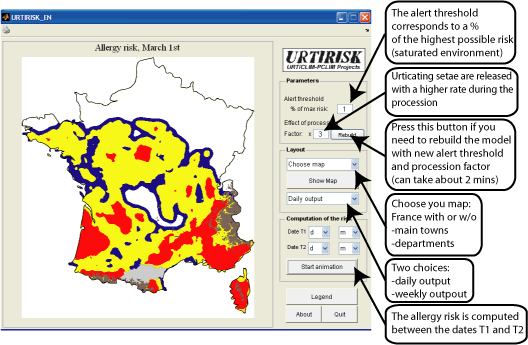
- MULTILAND: neutral landscape generator. The landscape may include several types of regions, with an exact control of the proportions occupied by each type of region, and a precise control of the level of fragmentation. Webpage: MULTILAND
